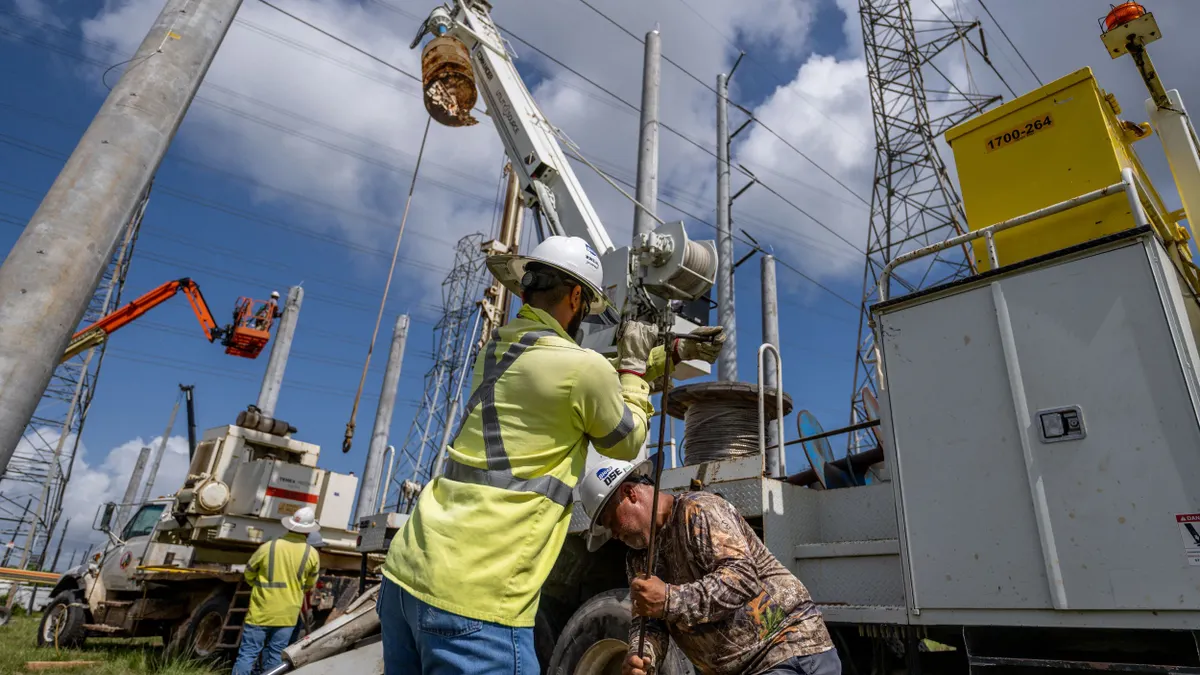The following is a viewpoint by Doug Karpa, policy director at Clean Coalition
California needs a serious conversation about the exploding costs of transmission.
In the current debate about whether to implement a western regional transmission operator (RTO) through the California Independent System Operator (CAISO) expansion, the missing discussion is how much it will cost to build and maintain a transmission system that can handle the increased regional energy transfers that such an RTO would generate.
Why transmission costs have been skyrocketing
For years, transmission costs in the U.S. have been growing far faster than inflation, sometimes at double-digit rates (see the figure below). This growth rate will continue if policymakers don't tackle this problem.
Proponents of creating a western RTO offer rosy predictions that an RTO can realize significant benefits using solely the existing transmission system. But history suggests that integrating larger territories leads to building new transmission links to allow instant dispatch from anywhere to anywhere else in the new larger territory, driving up transmission costs for ratepayers.
Given the optimistic assumptions of proponents of a western RTO that minimal new transmission would be built, even a slight increase in transmission would eat up all projected ratepayer savings. If the new western RTO decides significant new transmission is necessary, CAISO expansion will flip from a cost savings to a new expensive project.
In California, electricity and transmission costs have been outpacing inflation for decades. In the 1990s, California's market deregulation and the creation of the California Independent System Operator (CAISO) triggered an explosion in transmission growth for two reasons. First, there was a perceived need for new transmission links between the old siloed utility service territories. Second, there was a misperception that central energy generation was the least expensive form of energy, because the costs of delivery were basically ignored as the same charges were applied to energy consumption regardless of how much the transmission system was used to deliver the energy.
Ignoring those delivery costs drove transmission growth as load-serving entities (LSEs) favored distant energy generation, even as local renewables became cost-effective. Given this history, proponents of CAISO expansion should face a heavy burden of proof to show that the RTO would not cause a similar explosion of transmission links between balancing areas. California lawmakers must ask for this proof before voting to expand to an RTO.
Containing transmission costs will save ratepayers billions
The cost growth risk associated with expanding CAISO into an RTO is underscored by the reluctance of CAISO and California's investor-owned utilities (IOUs) to reform the transmission charges system in order to constrain transmission growth.
Today, California's transmission charges in investor-owned utility (IOU) territories completely fail to recognize the cost-saving benefits of local wholesale distributed generation (WDG), a proven approach to reducing spending on transmission infrastructure. Instead of factoring in the systemic cost savings offered by WDG, California's IOU transmission charges are exactly the same regardless how much its energy sources drive transmission costs.
Ignoring the real cost savings offered by WDG creates a serious market distortion and drives up transmission costs by hiding the growing cost of transmission for remote generation, while discriminating against local energy solutions, such as mid-scale, in-front-of-the-meter wholesale distributed generation. Transmission charges reform is needed to address this issue.
This is exactly the kind of barrier to WDG that California's SB 350 Barriers Report called for removing to enable the economic advantages of WDG "to be readily accessible to low-income and disadvantaged populations across California." At a time when California already has the highest cost-of-living-adjusted poverty rate in the United States, California policymakers need to take a long, hard look at the regressive impacts of excessive transmission spending on the state's ratepayers.
In order to contain the growth of ratepayer costs, lawmakers should focus on ensuring that California's transmission rates provide LSEs with the price signal they need to make the best procurement decisions for ratepayers — reflecting both generation and delivery costs.
Instead of chasing speculative ratepayer savings from a CAISO expansion, California's policymakers should institute a comprehensive statewide process to reform the way that transmission charges are metered and allocated so they are sensible and consistent across all LSEs. According to first-order modeling done by the Clean Coalition, this reform could save ratepayers as much as $60 billion within 20 years, or roughly $3 billion a year.
Deploying local energy solutions such as WDG is a critical cost-containment measure that has contributed to the cancellation of billions of dollars in transmission projects in recent years. If further contributions like these restrain the growth rate of transmission costs even slightly, ratepayers could save billions of dollars, as shown in the table below.
For example, if current transmission costs grow by even 8% a year (a conservative assumption, given that transmission costs have seen close to 12.5% annual growth from 2008 through 2018), California ratepayers would pay a total $121 billion over 20 years to support CAISO's high-voltage transmission grid. But if that cost growth rate goes down to 6% because of local energy generation, California ratepayers would save more than $25 billion. The savings increase significantly with each percentage point in transmission cost reduction.
| Transmission cost growth rate reduction from local energy | Resulting transmission cost growth rate | Total ratepayer payments over 20 years (billions of $) | Total ratepayer savings over 20 years (billions of $) |
|---|---|---|---|
|
Baseline |
8% |
$121 |
N/A |
|
2% |
6% |
$96 |
$25.03 |
|
4% |
4% |
$77 |
$44.29 |
|
6% |
2% |
$62 |
$59.14 |
Unless we slow the growth rate of transmission costs, Californians will face sharply climbing transmission costs in the coming decades — with transmission charges growing from roughly 2 cents per kWh today to as much as a real 4.5 cents per kWh within 20 years. Unleashing clean local energy resources would offset the need for new transmission, which would help contain these costs.
Fixing the transmission charges distortion
Any analysis that takes a serious look at the true cost causation in transmission planning recognizes that remotely generated energy and local WDG have different impacts on transmission costs. Ignoring these real cost differences is a recipe for disaster. Until transmission charges in IOU territories are fixed so that they reflect the real differences in the demand for new transmission they generate, unnecessary transmission spending will continue to expand.
It is a basic principle of economics that if a resource appears to be free to use, it will be over-consumed. Under the current Transmission Access Charges (TAC) system, IOUs and community choice aggregators (CCAs) have no incentive to choose energy sources that provide ratepayers with the lowest overall cost, because they don't pay the delivery costs: ratepayers do. Reforming this system is hardly a new idea; non-participating municipal utilities in California have been using a more accurate transmission charge system to reflect these differences for decades.
Taking action will require leadership from state policymakers, because all of California's major IOUs own and make hefty returns on transmission infrastructure. As a result, IOUs are perversely incentivized to promote over-building of transmission, driving up costs for all ratepayers. Currently CAISO also appears to have limited appetite to address the problem. As a result, a vicious cycle drives over-procurement of remote generation, which drives demand for transmission infrastructure investment, which then exacerbates transmission costs — ultimately costing ratepayers billions of dollars.
Failing to fix the transmission charges problem before expanding CAISO into a multi-state, multi-national RTO will simply proliferate this problem and could eliminate any potential savings from CAISO expansion. Even with very optimistic assumptions that no new transmission will be built, the savings from an RTO amount to just a little more than $1.4 billion a year. If those optimistic assumptions are wrong by so much as a single long-distance high-voltage line, all the savings evaporate completely.
When we compare the potential $1.4 billion annual savings under this optimistic scenario with the potential $2 – $3 billion annual savings we could realize by fixing the current transmission charges market distortion, the correct policy priority becomes clear. Unless we address the known market distortions caused by flawed transmission charges, any savings from creating an RTO may well prove to be illusory.
California's opportunity to take bold action
Taking the transmission-centric RTO approach to solving energy challenges will likely inflict high costs on ratepayers.
We need to consider the cheaper and more reliable alternatives before taking on the substantial risks of creating a multi-state RTO.
By addressing the transmission charges issue, California has a tremendous opportunity to develop a solid solution to a growing national problem in transmission spending. Charges for transmission should be aligned with the drivers of the need for transmission spending — costs that are very different for remote energy sources than for local ones.
Ultimately, California must have the autonomy to forge new paths and take new approaches that others will not. Saddling ourselves with a risky and expensive transmission-centric RTO would likely cost ratepayers vast sums while spreading existing market distortions across the West.





















